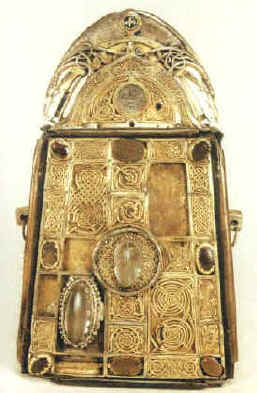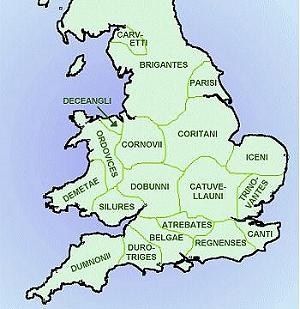|

St. Patrick's Bell Shrine - 11th century
|
|
The term Celtic and the Celtic people
themselves are both hard to define and often misunderstood and
misinterpreted. It is generally agreed that the roots of the culture began to develop
some 4000 years ago in northern Europe with successive waves of settlers
moving into and around Britain over the next 2000 years. It is
however, the dawning of the Iron Age sometime between 700 and 500 BC that
sees the loose scattered communities amalgamating into the powerful
tribal groups that we now know existed due to the written accounts of the
Roman invaders. It is these people that became the Celts of legend
and to whom we attribute the first coherent artistic style, known as La
Tène. This form of art is characterised by abstract patterns, of spirals,
stylised representation of animals and plants and occasionally the
distorted forms of their gods heads. With the coming of the Romans, the
Celtic tribes were organised into a form of semi-autonomous provincial governing bodies
known as civitates and the artists borrowed many of the techniques and
technologies that their new rulers brought with them. Artwork was applied
increasingly to functional objects - brightly enamelled horse trappings
and brooches both became very popular.
After the Romans had left Britain
in the 5th century and during the following Dark Ages, the invading
Anglo-Saxons continued some of the Celtic art traditions in their own
work, such as the bronze bowl decorated with scrolls and red enamel found
in the burial ship at Sutton Hoo in Suffolk. However, it was in the areas
that had remained largely out of the control of the Romans, such as
Ireland and the north of Britain, areas that were now Christianised, that
Celtic art flourished. The great illuminated Gospels of Lindisfarne, the
Book of Durrow and the Book of Kells all from around the 7-8th century,
feature brightly coloured
|

Celtic Tribal Britain at the
time of
the Roman conquest
|
and intricately interlaced patterning, sometimes
including human and animal forms and highly ornate illuminated Latin
script.
Similarly, carved stone crosses of the period feature complicated panels
of interlacing as
well as scenes from the old and new testament. Metalwork, consisting of
brooches, chalices, processional crosses and reliquaries (caskets for relics) made
from gold, silver, bronze and copper with filigree interlacing and
studs of enamel and crystal represent probably the culmination of the
artist's skills, and continued to be made until the 12th century when the
monastic tradition was replaced by the more formal Episcopal church model
that was now widespread throughout Europe The golden age of Celtic art now
came to a close, only to resurface again in the 19th and 20th century, as
many new artists began to draw from it's rich heritage, sometimes to
emulate the styles and techniques of past work, others to take it's
influence and use it to create new and exciting art that carries the
Celtic tradition on into a new millennium.
|

